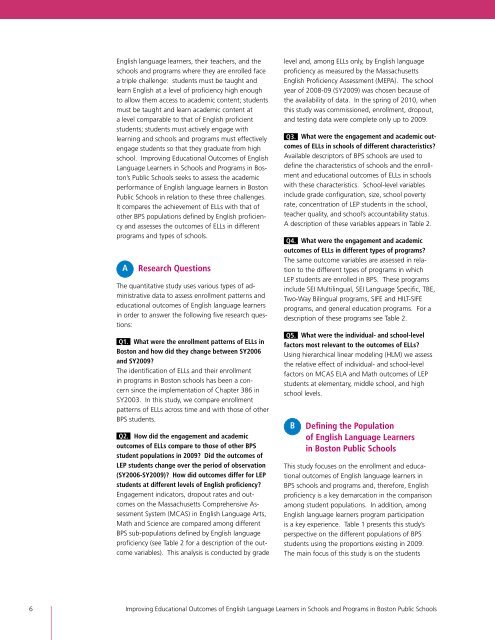Full Report - Center for Collaborative Education
Full Report - Center for Collaborative Education
Full Report - Center for Collaborative Education
You also want an ePaper? Increase the reach of your titles
YUMPU automatically turns print PDFs into web optimized ePapers that Google loves.
English language learners, their teachers, and the<br />
schools and programs where they are enrolled face<br />
a triple challenge: students must be taught and<br />
learn English at a level of proficiency high enough<br />
to allow them access to academic content; students<br />
must be taught and learn academic content at<br />
a level comparable to that of English proficient<br />
students; students must actively engage with<br />
learning and schools and programs must effectively<br />
engage students so that they graduate from high<br />
school. Improving <strong>Education</strong>al Outcomes of English<br />
Language Learners in Schools and Programs in Boston’s<br />
Public Schools seeks to assess the academic<br />
per<strong>for</strong>mance of English language learners in Boston<br />
Public Schools in relation to these three challenges.<br />
It compares the achievement of ELLs with that of<br />
other BPS populations defined by English proficiency<br />
and assesses the outcomes of ELLs in different<br />
programs and types of schools.<br />
A Research Questions<br />
The quantitative study uses various types of administrative<br />
data to assess enrollment patterns and<br />
educational outcomes of English language learners<br />
in order to answer the following five research questions:<br />
Q1. What were the enrollment patterns of ELLs in<br />
Boston and how did they change between SY2006<br />
and SY2009?<br />
The identification of ELLs and their enrollment<br />
in programs in Boston schools has been a concern<br />
since the implementation of Chapter 386 in<br />
SY2003. In this study, we compare enrollment<br />
patterns of ELLs across time and with those of other<br />
BPS students.<br />
Q2. How did the engagement and academic<br />
outcomes of ELLs compare to those of other BPS<br />
student populations in 2009? Did the outcomes of<br />
LEP students change over the period of observation<br />
(SY2006-SY2009)? How did outcomes differ <strong>for</strong> LEP<br />
students at different levels of English proficiency?<br />
Engagement indicators, dropout rates and outcomes<br />
on the Massachusetts Comprehensive Assessment<br />
System (MCAS) in English Language Arts,<br />
Math and Science are compared among different<br />
BPS sub-populations defined by English language<br />
proficiency (see Table 2 <strong>for</strong> a description of the outcome<br />
variables). This analysis is conducted by grade<br />
level and, among ELLs only, by English language<br />
proficiency as measured by the Massachusetts<br />
English Proficiency Assessment (MEPA). The school<br />
year of 2008-09 (SY2009) was chosen because of<br />
the availability of data. In the spring of 2010, when<br />
this study was commissioned, enrollment, dropout,<br />
and testing data were complete only up to 2009.<br />
Q3. What were the engagement and academic outcomes<br />
of ELLs in schools of different characteristics?<br />
Available descriptors of BPS schools are used to<br />
define the characteristics of schools and the enrollment<br />
and educational outcomes of ELLs in schools<br />
with these characteristics. School-level variables<br />
include grade configuration, size, school poverty<br />
rate, concentration of LEP students in the school,<br />
teacher quality, and school’s accountability status.<br />
A description of these variables appears in Table 2.<br />
Q4. What were the engagement and academic<br />
outcomes of ELLs in different types of programs?<br />
The same outcome variables are assessed in relation<br />
to the different types of programs in which<br />
LEP students are enrolled in BPS. These programs<br />
include SEI Multilingual, SEI Language Specific, TBE,<br />
Two-Way Bilingual programs, SIFE and HILT-SIFE<br />
programs, and general education programs. For a<br />
description of these programs see Table 2.<br />
Q5. What were the individual- and school-level<br />
factors most relevant to the outcomes of ELLs?<br />
Using hierarchical linear modeling (HLM) we assess<br />
the relative effect of individual- and school-level<br />
factors on MCAS ELA and Math outcomes of LEP<br />
students at elementary, middle school, and high<br />
school levels.<br />
B Defining the Population<br />
of English Language Learners<br />
in Boston Public Schools<br />
This study focuses on the enrollment and educational<br />
outcomes of English language learners in<br />
BPS schools and programs and, there<strong>for</strong>e, English<br />
proficiency is a key demarcation in the comparison<br />
among student populations. In addition, among<br />
English language learners program participation<br />
is a key experience. Table 1 presents this study’s<br />
perspective on the different populations of BPS<br />
students using the proportions existing in 2009.<br />
The main focus of this study is on the students<br />
6 Improving <strong>Education</strong>al Outcomes of English Language Learners in Schools and Programs in Boston Public Schools


